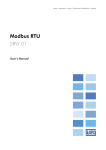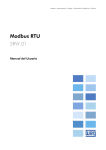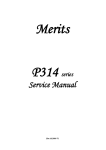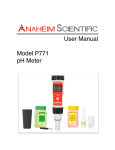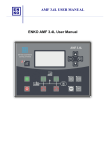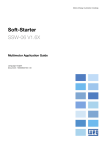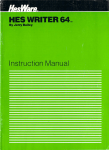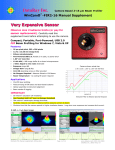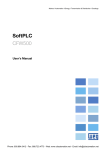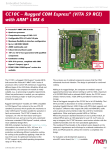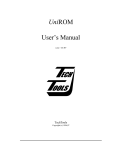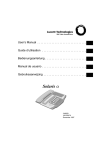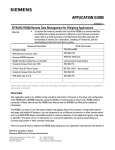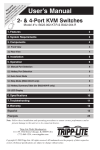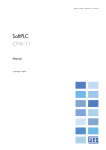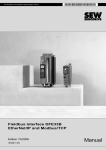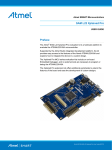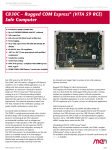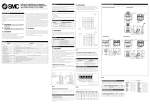Download SRW01 - CommunicationModBus-RTU (v.4.0X)
Transcript
Motors | Automation | Energy | Transmission & Distribution | Coatings SMART RELAY SRW 01 V4.0X Modbus-RTU Communication Manual Modbus-RTU Communication Manual Series: SRW 01 Firmware Version: V4.0X Language: English Document Number: 10000521657 / 04 Publication Date: 12/2012 Summary SUMMARY ABOUT THIS MANUAL .................................................................................... 7 ABBREVIATIONS AND DEFINITIONS ............................................................................................. 7 NUMERICAL REPRESENTATION .................................................................................................... 7 1 INTRODUCTION TO SERIAL COMMUNICATION ............................................. 9 1.1 THE MODBUS-RTU PROTOCOL .............................................................................................. 9 1.2 TRANSMISSION MODES ........................................................................................................ 9 1.3 RTU MODE MESSAGE STRUCTURE .......................................................................................... 9 1.3.1 Address .......................................................................................................................... 9 1.3.2 Function Code ............................................................................................................... 10 1.3.3 Data Field..................................................................................................................... 10 1.3.4 CRC ............................................................................................................................. 10 2 ACCESSORY KIT ..........................................................................................11 2.1 MODBUS-RTU INTERFACE.................................................................................................... 11 2.1.1 Modbus-RTU Kit............................................................................................................. 11 2.1.3 Power Supply ................................................................................................................ 12 2.2 CONNECTION WITH THE NETWORK .................................................................................... 12 2.3 MODULE CONFIGURATION................................................................................................. 12 2.4 STATUS INDICATION .......................................................................................................... 12 3 RELAY PARAMETERIZATION ........................................................................13 P202 – OPERATION MODE........................................................................................................ 13 P220 – LOCAL/REMOTE SELECTION ........................................................................................... 13 P232 – REMOTE COMMAND SELECTION .................................................................................... 13 P277 – DIGITAL OUTPUT O1 FUNCTION .................................................................................... 13 P278 – DIGITAL OUTPUT O2 FUNCTION .................................................................................... 13 P279 – DIGITAL OUTPUT O3 FUNCTION .................................................................................... 13 P280 – DIGITAL OUTPUT O4 FUNCTION .................................................................................... 13 P281 – DIGITAL OUTPUT O5 FUNCTION .................................................................................... 14 P282 – DIGITAL OUTPUT O6 FUNCTION .................................................................................... 14 P283 – DIGITAL OUTPUT O7 FUNCTION .................................................................................... 14 P284 – DIGITAL OUTPUT O8 FUNCTION .................................................................................... 14 P313 – COMMUNICATION ERROR ACTION ................................................................................ 14 P314 – SERIAL WATCHDOG....................................................................................................... 15 P725 – COMMUNICATION MODULE ADDRESS ........................................................................... 15 P726 – DEVICENET/MODBUS BOARD BAUD RATE ....................................................................... 16 P770 – READING PROGRAMMABLE PARAMETER #1 ..................................................................... 16 P771 – READING PROGRAMMABLE PARAMETER #2 ..................................................................... 16 P772 – READING PROGRAMMABLE PARAMETER #3 ..................................................................... 16 P773 – READING PROGRAMMABLE PARAMETER #4 ..................................................................... 16 P774 – READING PROGRAMMABLE PARAMETER #5 ..................................................................... 16 P775 – READING PROGRAMMABLE PARAMETER #6 ..................................................................... 16 P780 – VALUE OF THE READING PROGRAMMABLE PARAMETER #1 ............................................... 16 P781 – VALUE OF THE READING PROGRAMMABLE PARAMETER #2 ............................................... 16 P782 – VALUE OF THE READING PROGRAMMABLE PARAMETER #3 ............................................... 16 P783 – VALUE OF THE READING PROGRAMMABLE PARAMETER #4 ............................................... 16 P784 – VALUE OF THE READING PROGRAMMABLE PARAMETER #5 ............................................... 16 P785 – VALUE OF THE READING PROGRAMMABLE PARAMETER #6 ............................................... 16 4 MODBUS-RTU COMMANDS USED AT THE SRW 01 ........................................17 4.1 01H 4.2 02H 4.3 03H 4.4 05H 4.5 06H COMMAND: READ COIL STATUS................................................................................... 17 COMMAND: READ INPUT STATUS ................................................................................. 17 COMMAND: READ HOLDING REGISTER......................................................................... 17 COMMAND: FORCE SINGLE COIL................................................................................. 18 COMMAND: PRESET SINGLE REGISTER .......................................................................... 18 Summary 4.6 0FH COMMAND: FORCE MULTIPLE COILS ............................................................................ 19 4.7 10H COMMAND: PRESET MULTIPLE REGISTERS...................................................................... 19 5 CONFIGURATION, COMMAND AND MONITORING VIA MODBUS .................21 5.1 WLP USE IN MODBUS ......................................................................................................... 21 6 ERROR RELATED TO THE SERIAL COMMUNICATION ......................................23 E0086 – SERIAL COMMUNICATION TIMEOUT ............................................................................. 23 About this Manual ABOUT THIS MANUAL This manual supplies the necessary information for the operation of the SRW 01 smart relay using the Modbus-RTU protocol. This manual must be used together with the SRW 01 user manual. ABBREVIATIONS AND DEFINITIONS ASCII PLC HMI WORD American Standard Code for Information Interchange Programmable Logic Controller Human-Machine Interface 16 bit Word NUMERICAL REPRESENTATION Decimal numbers are represented by means of digits without suffix. Hexadecimal numbers are represented with the letter ‘h’ after the number. 7 About this Manual 8 Introduction to Serial Communication 1 INTRODUCTION TO SERIAL COMMUNICATION In a serial interface the data bits are sent sequentially through a communication channel or bus. Several technologies use the serial communication for data transfer, including the RS232 and RS485 interfaces. The directions that specify the RS232 and RS485 standards, however, do neither specify the character format, nor its sequence for the data transmission and reception. Therefore, besides the interface, it is also necessary to identify the protocol used for the communication. Among the several existent protocols, one used a lot in the industry is the Modbus-RTU protocol. In the sequence the characteristics of the RS485 serial interface available for the SRW 01 smart relay will be presented, as well as the Modbus-RTU protocol for the use of this interface. 1.1 THE MODBUS-RTU PROTOCOL The Modbus protocol was developed by the company Modicon, part of Schneider Automation. It is defined in the protocol: the format of the messages used by the elements that compose the Modbus network, the services (or functions) that can be made available via network, and also how these elements exchange data in the network. 1.2 TRANSMISSION MODES Two transmission modes are defined in the protocol specification: ASCII and RTU. The modes define the way the message bytes are transmitted. It is not possible to use the two transmission modes in the same network. In the RTU mode, each transmitted word has 1 start bit, eight data bits, 2 stop bits, and without parity. Thus, the bit sequence for one byte transmission is the following: Start B0 B1 B2 B3 B4 B5 B6 B7 Stop Stop In the RTU mode each data byte is transmitted as a single word with its value in hexadecimal format. The SRW 01 uses only this transmission mode for communication, not having, therefore, the ASCII communication mode. 1.3 RTU MODE MESSAGE STRUCTURE The Modbus-RTU structure uses a master-slave system for message exchange. It allows up to 247 slaves, but only one master. Every communication begins with the master making a request to a slave, which answers to the master what has been asked. In both telegrams (request and answer), the used structure is the same: Address, Function Code, Data and Checksum. Only the data content has a variable size. Master request message Address (1 byte) Function code (1 byte) Data (n bytes) CRC (2 bytes) Address (1 byte) Function code (1 byte) Data (n bytes) CRC (2 bytes) Slave response message Figure 1.1 – Message structure 1.3.1 Address The master initiates the communication sending a byte with the address of the slave to which the message is destined. When sending the response, the slave also initiates the telegram with its own address, making it possible to the master to know which slave is sending the response. 9 Introduction to Serial Communication The master can also send a message to the address 0 (zero), which means that the message is destined to all the slaves in the network (broadcast). In that case, no slave will answer to the master. 1.3.2 Function Code This field also contains a single byte, where the master specifies the kind of service or function requested to the slave (reading, writing, etc.). According to the protocol, each function is used to access a specific type of data. In the SRW 01, data is made available as holding registers (words) or coil/input discrete registers (bits); therefore, the relay does only accept functions that manipulate this type of data. 1.3.3 Data Field It is a variable size field. The format and contents of this field depend on the used function and on the transmitted values. This field is described together with the description of the functions. 1.3.4 CRC The last part of the telegram is the field for checking the transmission errors. The used method is the CRC-16 (Cycling Redundancy Check). This field is formed by two bytes; where first the least significant byte is transmitted (CRC-), and then the most significant (CRC+). The CRC calculation is initiated by loading a 16 bit variable (from now on referred to as CRC variable) with the FFFFh value. Then the steps of the following routine are executed: 1. The first byte of the message (only the data bits – start bit, parity and stop bits are not used) is submitted to an XOR (exclusive OR) logic, with the 8 low order bits of the CRC variable, returning the result to the own CRC variable; 2. Then the CRC variable is shifted to the right, towards the least significant bit, and the most significant bit position is filled with 0 (zero); 3. After this shift the flag bit (the bit that was shifted out of the CRC variable) is analyzed, with the following outcomes: If the bit value is 0 (zero), nothing is done; If the bit value is 1, the content of the CRC variable is submitted to an XOR logic with a constant value of A001h and the result is returned to the CRC variable. 4. The steps 2 and 3 are repeated until eight shifts have been made; 5. The steps 1 to 4 are repeated, using the next message byte, until the entire message has been processed. The final content of the CRC variable is the CRC field value that is transmitted at the end of the telegram. The least significant part is transmitted first (CRC-) and next the most significant part (CRC+). 10 Acessory Kit 2 ACCESSORY KIT In order to make the Modbus-RTU communication possible with the SRW 01 smart relay, it is necessary to use a kit for Modbus-RTU communication, according to the description below. Information on this module installation can be obtained in the installation guide that comes with the kit. 2.1 MODBUS-RTU INTERFACE 2.1.1 Modbus-RTU Kit Composed by the Modbus-RTU communication module (figure at the left) and an installation guide. The interface follows the EIA-485 standard. The interface is electrically isolated and with differential signal, which grants more robustness against electromagnetic interference. The maximum distance for the connection of the devices is 1000 m. Network termination via switch, which must be turned on at the network extremes. 2.1.2 Connector Pin Functions Once the Modbus-RTU communication kit has been installed, the relay makes available two different connectors for the interface with the network: Female DB9 connector (XC15). 8-wire plug-in terminal strip (XC2). Table 2.1 – 8-wire plug-in terminal strip (XC2) pinout for the Modbus-RTU interface XC15 Pin A B PE BK BU SH WH RD Signal A B PE BK BU SH WH RD Function A-Line(-) B-Line(+) Protection Earth (shield) Not used by Modbus Not used by Modbus Not used by Modbus Not used by Modbus Not used by Modbus Table 2.2 – DB9 (XC15) connector pinout for the ModbusRTU interface XC2 Pin 1 2 3 4 5 6 7 8 9 Frame Signal NC NC B NC GND(ISO) +5V(ISO) NC A NC PE Function Not used by Modbus Not used by Modbus B-Line(+) (Modbus) Not used by Modbus Not used by Modbus Not used by Modbus Not used by Modbus A-Line(-) (Modbus) Not used by Modbus Protection Earth (shield) NC = not connected. 11 Accessory Kit ATTENTION! Terminal strip XC2 pin PE must obligatorily be connected to a protective earth, even if the used connector is DB9 (XC15). 2.1.3 Power Supply The SRW 01 Modbus-RTU interface does not require external power supply. The communication module already has an internal isolated power supply. 2.2 CONNECTION WITH THE NETWORK The following point must be observed for the connection of the relay using the Modbus-RTU interface: The use of specific Modbus-RTU network cables is recommended; The grounding of the cable shield is at only one point, in order to avoid current loops; Switch on the termination resistor DIP-switch only at the extremes of the main bus, even if there are derivations. 2.3 MODULE CONFIGURATION In order to configure the Modbus-RTU module, follow the steps indicated below: With the relay off, install the Modbus-RTU communication module into the slot located at the bottom of the equipment; Make sure it is fitted in properly; Apply power to the relay; Verify the content of the parameter P084 making sure that the communication module has been properly recognized (P084 = 1). If necessary, refer to the installation guide and to the user manual; Set the relay network address through the parameter P725: - Valid values: 0 to 247. Set the baud rate at P726. Valid values: - 0 = 4.8 kbit/s - 1 = 9.6 kbit/s - 2 = 19.2 kbit/s - 3 = 38.4 kbit/s Connect the network cable wires to the XC2 connector (or the DB9). Refer to the section 3 or to the user manual for more information on the parameters mentioned above. 2.4 STATUS INDICATION At the SRW 01 front panel there is a bicolor LED named ‘NET’, which signalizes in GREEN when the Modbus-RTU communication module is correctly connected. The same LED flashes in RED when the relay has acknowledged any message from the master and is responding. 12 Relay Parameterization 3 RELAY PARAMETERIZATION Next only the SRW 01 smart relay parameters related to the Modbus-RTU communication will be presented. The detailed description of this parameter is found in the SRW 01 User Manual. P202 – Operation Mode Adjustable Range: Properties: 0 = Transparent 1 = Overload Relay 2 = Direct Start 3 = Reverse Start 4 = Star-Delta Start 5 = Dahlander Start 6 = Pole-Changing Start 7 = PLC Mode Factory default: 1 Sys, CFG Description: This parameter allows selecting the SRW 01 operation mode. The functions of digital inputs and outputs are configured automatically according to this selection. P220 – Local/Remote Selection Adjustable Range: 0 = Always Local 1 = Always Remote 2 = HMI key (LOC) 3 = HMI key (REM) 4 = Digital Input I3 5 = Digital Input I4 6 = Fieldbus (LOC) 7 = Fieldbus (REM) 8 = USB/Ladder Factory default: 2 Properties: Sys, rw Description: This parameter defines the origin of the command that will select the SRW 01 working mode (Local/Remote) and its initial state. P232 – Remote Command Selection Adjustable Range: 0= 1= 2= 3= Ix HMI USB/Ladder Fieldbus Factory default: 3 Properties: Sys, rw Description: It defines the origin of the remote commands. If P232 = 3, the remote commands are controlled by the industrial network master. P277 – Digital Output O1 Function P278 – Digital Output O2 Function P279 – Digital Output O3 Function P280 – Digital Output O4 Function 13 Relay Parameterization P281 – Digital Output O5 Function P282 – Digital Output O6 Function P283 – Digital Output O7 Function P284 – Digital Output O8 Function Adjustable Range: Properties: 0 = Internal use (P202) 1 = Ladder 2 = Fieldbus 3 = Alarm/Fault (NO) Signal 4 = Trip/Error (NO) Signal 5 = Trip/Error (NC) Signal Factory default: 1 Sys, CFG Description: They define the relay output control origin. Internal Use: it is used according to the selected operation mode (P202). It indicates that the digital output has a pre-defined function for that operation mode; Ladder: it is used by the user program implemented in Ladder; F ieldbus: it is used directly by the industrial network master. Alarm/F ault ( N O) Signal: it is used to signal Alarm or Fault. In case of Alarm or Fault the output is closed, remaining like this until the cause of failure is not present anymore and the reset control is set. Trip/Error (NO) Signal: it is used to signal Trip or Error. In case of Trip or Error (Ex. No communication with the Current Measuring Unit) the output is closed, remaining this until the cause of the failure is not present anymore and the reset control is set. Trip/Error (NC) Signal: it is used to signal Trip or Error. In case of Trip or Error (Ex. No communication with the Current Measuring Unit) the output is closed, remaining like this until the cause of the failure is not present anymore and the reset control is set. NOTE! It is worthwhile to remember that the availability of the digital outputs (O1-O4) depends on the used operation mode, because it is possible that one or more outputs be already pre-allocated for other functions. P313 – Communication Error Action Adjustable Range: Properties: 0 = Only indicates fault 1 = Stops motor 2 = Stops motor and resets commands 3 = Goes to local Factory default: 0 Sys, rw Description: This parameter allows selecting which action must be executed by the relay, in case that a communication error is detected. 14 Relay Parameterization Table 3.1 – Values for the parameter P313 Options 0 = Only indicates fault 1 = Stops motor 2 = Stops motor and resets commands 3 = Goes to local Description Fault indication only with no action taken. The indication of fault will be automatically removed if the fault condition is cleared and the relay status are not either TRIP or Error. If the relay status is TRIP or Error, it is mandatory to perform “error reset” in order to remove the fault indication. It switches the motor off, for the operation modes where this commands exists. It is necessary to perform the error reset in order to remove the indication. It switches the motor off and resets the commands. It is necessary to perform the error reset in order to remove the indication. It changes to local mode, providing that the local/remote selection is programmed to be executed via Fieldbus. The indication of fault will be automatically removed if the fault condition is cleared and the relay status are not either TRIP or Error. If the relay status is TRIP or Error, it is mandatory to perform “error reset” in order to remove the fault indication. For the Modbus-RTU interface, the following event is considered communication error: E0086: Timeout in the data communication of the Modbus-RTU interface has occurred. The description of these errors is presented in the section 6. P314 – Serial Watchdog Adjustable Range: Properties: 0.0 = Disabled 0.1 to 999.0 s = Enabled Sys, CFG Factory default: 0.0 Description: It allows the programming of a time limit for the detection of serial interface communication error. In case the SRW 01 remains without receiving valid telegrams longer than the time programmed in this parameter, it will be considered that a communication error happened, the message "E0086" be showed on the HMI and the option programmed in P313 will be executed. After being powered up, the SRW 01 starts counting this time from the first received valid telegram. The value 0.0 disables this function. P725 – Communication Module Address Adjustable Range: Properties: 0 to 255 Factory default: 63 Sys, CFG Description: It allows programming the address relay communication board. It is necessary that each device in the network has an address different from the others. The valid addresses for this parameter depend on the used protocol: Modbus → valid addresses: 1 to 247. DeviceNet → valid addresses: 0 to 63. Profibus → valid addresses: 1 to 125. If this parameter is changed, it is not necessary to turn off and on again the relay to make the address valid (only for Modbus-RTU network). 15 Relay Parameterization P726 – DeviceNet/Modbus Board Baud Rate Adjustable range: Properties: 0 = 125 Kbit/s 4.8 Kbit/s 1 = 250 Kbit/s 9.6 Kbit/s 2 = 500 Kbit/s 19.2 Kbit/s 3 = Autobaud/ 38.4 Kbit/s Factory default: 3 Sys, CFG Description: It allows programming the desired baud rate for the DeviceNet and Modbus boards, in bits per second. This rate must be the same for all the devices connected to the network. The values at the right (above) refer exclusively to the Modbus-RTU network. P770 – Reading Programmable Parameter #1 P771 – Reading Programmable Parameter #2 P772 – Reading Programmable Parameter #3 P773 – Reading Programmable Parameter #4 P774 – Reading Programmable Parameter #5 P775 – Reading Programmable Parameter #6 Adjustable Range: Properties: 0 to 999 Factory default: 0 Sys, rw Description: These parameters allow the user to, via network, program the monitoring of up to six parameters in a sequence. The contents of the parameters are shown in the parameters P780 to P785. P780 – Value of the Reading Programmable Parameter #1 P781 – Value of the Reading Programmable Parameter #2 P782 – Value of the Reading Programmable Parameter #3 P783 – Value of the Reading Programmable Parameter #4 P784 – Value of the Reading Programmable Parameter #5 P785 – Value of the Reading Programmable Parameter #6 Adjustable Range: 0 to 65535 Factory default: 0 Properties: RO Description: Present the content of the parameters defined on P770 to P775. For example, P770 = 5. In this case, the content of parameter P005 (frequency out of range) will be sent via network to the parameter P780. 16 Modbus-RTU Commands Used at the SRW 01 4 MODBUS-RTU COMMANDS USED AT THE SRW 01 The following commands (functions) were implemented in the Modbus-RTU protocol of the SRW 01 smart relay, following the specifications found at www.modbus.org: Modbus_over_serial_line_V1_02.pdf Modbus_Application_Protocol_V1_1b.pdf 01h 02h 03h 05h 06h 0Fh 10h Command: Command: Command: Command: Command: Command: Command: Read Coil Status Read Input Status Read Holding Register Force Single Coil Preset Single Register Force Multiple Coils Preset Multiple Registers In order to get information on the implementation of the mentioned commands, refer to the indicated specifications. 4.1 01H COMMAND: READ COIL STATUS Use this function to read bit markers and digital outputs. Multiple coils can be read simultaneously, provided that their addresses are adjacent, for instance, MX6100 to MX6110. The system markers SX3001 to SX3006 do not allow multiple reading, i.e., each marker must be read individually. Data Type Bit Markers (Ladder) Digital Outputs (Control Unit) Digital Outputs (Expansion Unit) Remote Command 1 Remote Command 2 Remote Command 3 Energized Motor Local/Remote Range MX6100 to MX7507 QX1 to QX4 (O1 to O4) QX5 to QX8 (O5 to O8) SX3001 SX3002 SX3003 SX3005 SX3006 Address 6100 to 7507 2401 to 2404 2405 to 2408 3001 3002 3003 3005 3006 The ‘Remote Commands’ are used to start, stop, change the speed, etc. of the motor, when a specific operation mode is selected in P202. ‘Local/Remote’ indicates the source of the SRW 01 commands, when SX3006=1, the SRW 01 is in remote mode. 4.2 02H COMMAND: READ INPUT STATUS It is used specifically for reading the digital inputs. Data Type Digital Inputs (Control Unit) Digital Inputs (Expansion Unit) Range IX1 to IX4 (I1 to I4) IX5 to IX10 (I5 to I10) Address 2201 to 2204 2205 to 2210 4.3 03H COMMAND: READ HOLDING REGISTER It is used for the reading of multiple parameters or word markers. Data Type System Parameters User Parameters Word Markers Float Markers Macro Parameters PTC Reading Range P000 to P799 P800 to P899 MW8200 to MW8849 MF9000 to MF9174 PM3700 to PM3731 SW3300 Address 0 to 799 800 to 899 8200 to 8849 9000 to 9174 3700 to 3731 3300 17 Modbus-RTU Commands Used at the SRW 01 Note: The FLOAT markers (MF9000 to MF9174) use 4 bytes in the memory; so, they have to be read two and two. For instance, in order to read the float markers 9100 to 9104, the reading of 10 words is necessary, starting from the address 9100. The reading will be in the float format (IEEE 754). 4.4 05H COMMAND: FORCE SINGLE COIL It forces the status of a bit marker or a digital output, individually. Data Type Bit Markers Digital Outputs (Control Unit) Digital Outputs (Expansion Unit) Reset Command Remote Command 1 Remote Command 2 Remote Command 3 Local/Remote Range MX6100 to MX7507 QX1 to QX4 (O1 to O4) QX5 to QX8 (O5 to O8) SX3000 SX3001 SX3002 SX3003 SX3006 Address 6100 to 7507 2401 to 2404 2405 to 2408 3000 3001 3002 3003 3006 Notes: In order to write in one or more of the outputs via Modbus, it is necessary that at the respective parameters from P277 to P284, the option 2, Fieldbus, had been selected; The system marker SX3000 performs the Trip or Error reset command. The system markers SX3001 SX3003, which are called Remote Commands, are equivalent to the commands through digital inputs (for the 3-wire command, pushbuttons ) I1, I2 and I3, respectively, and they are used for commanding the motor, depending on the operation mode selected in P202. For instance: in the operation mode 'Reversing Starter', SX3001 turns off the motor, SX3002 starts it in the direct rotation and SX3003 starts the motor in the reverse rotation. In order that the Local/Remote mode be able to be selected, it is necessary that P220 = 6 or 7. Refer to the user manual in order to get more information regarding the parameters mentioned above. 4.5 06H COMMAND: PRESET SINGLE REGISTER It writes one word type datum, i.e., a marker or a parameter. Data Type System Parameters User Parameters Word Markers Float Markers Macro Parameters Range P000 to P799 P800 to P899 MW8200 to MW8849 MF9000 to MF9174 PM3700 to PM3731 Address 0 to 799 800 to 899 8200 to 8849 9000 to 9174 3700 to 3731 Note: The FLOAT markers (MF9000 to MF9174) use 4 bytes in the memory, so, they have to be written two and two. For instance, in order to write in the float markers 9100 to 9104, the writing of 10 words is necessary, starting from the address 9100, in the float format (IEEE 754). 18 Modbus-RTU Commands Used at the SRW 01 4.6 0FH COMMAND: FORCE MULTIPLE COILS It forces the writing of multiple bit type data, i.e., bit markers and digital outputs. Data Type Bit Markers Digital Outputs (Control Unit) Digital Outputs (Expansion Unit) Reset Command Remote Command 1 Remote Command 2 Remote Command 3 Local/Remote Range MX6100 to MX7507 QX1 to QX4 (O1 to O4) QX5 to QX8 (O5 to O8) SX3000 SX3001 SX3002 SX3003 SX3006 Address 6100 to 7507 2401 to 2404 2405 to 2408 3000 3001 3002 3003 3006 Notes: In order to write in one or more of the outputs via Modbus, it is necessary that at the respective parameters from P277 to P284, the option 2, Fieldbus, had been selected; The system marker SX3000 performs the Trip or Error reset command. The system markers SX3001 SX3003, which are called Remote Commands, are equivalent to the commands through digital inputs (for the 3-wire command, pushbuttons ) I1, I2 and I3, respectively, and they are used for commanding the motor, depending on the operation mode selected in P202. For instance: in the operation mode 'Reversing Starter', SX3001 turns off the motor, SX3002 starts it in the direct rotation and SX3003 starts the motor in the reverse rotation. In order that the Local/Remote mode be able to be selected, it is necessary that P220 = 6 or 7. Refer to the user manual in order to get more information regarding the parameters mentioned above. 4.7 10H COMMAND: PRESET MULTIPLE REGISTERS It is used for the writing of multiple word type data, in adjacent markers and parameters. Data Type System Parameters User Parameters Word Markers Float Markers Macro Parameters Range P000 to P799 P800 to P899 MW8200 to MW8849 MF9000 to MF9174 PM3700 to PM3731 Address 0 to 799 800 to 899 8200 to 8849 9000 to 9174 3700 to 3731 Observação: The FLOAT markers (MF9000 to MF9174) use 4 bytes in the memory, so, they have to be written two and two. For instance, in order to write in the float markers 9100 to 9104, the writing of 10 words is necessary, starting from the address 9100, in the float format (IEEE 754). 19 Modbus-RTU Commands Used at the SRW 01 20 Configuration, Command and Monitoring Via Modbus 5 CONFIGURATION, COMMAND AND MONITORING VIA MODBUS In order to configure the SRW 01, its operation modes, motor data, etc., as well as commanding it via Modbus (Fieldbus) and also to monitor data remotely, refer to the SRW 01 manual. 5.1 WLP USE IN MODBUS If there is an RS-485 interface connected to a personal computer (PC), the WLP software can be used for the configuration, monitoring and command, and also for transferring the user program, in Ladder, being necessary only to configure the correct used relay address in the WLP. Note that considering that the WLP is normally used in Local mode, the 'Remote Commands' are referenced by the software as 'Local Commands'. The RS-485 can be obtained at the PC through an RS-232 to RS-485 converter. 21 Configuration, Command and Monitoring Via Modbus 22 Error Related to the Serial Communication 6 ERROR RELATED TO THE SERIAL COMMUNICATION E0086 – Serial Communication Timeout Description: It indicates that the SRW 01 has stopped receiving valid serial telegrams for a period longer than the programmed in P314. Working: The parameter P314 allows the programming of a time during which the SRW 01 must receive at least one valid telegram via serial interface, with address and error checking field correct, otherwise, it will be considered that there was any problem in the serial communication. The time counting initiates after the reception of the first valid telegram. After the serial communication timeout has been identified, "E0086" will be showed on the SRW 01 HMI and the action programmed in P313 will execute. Case P313 will be configured to "only fault indication" (P313 = 0), if the communication is reestablished and new valid telegrams are received, the fault indication will be removed from the HMI. Possible Causes/Correction: Verify factors that could cause failures in the communication (cables, installation, and grounding). Make sure that the master sends telegrams to the SRW 01 in intervals shorter than the programmed in P314. Disable this function in P314. 23























